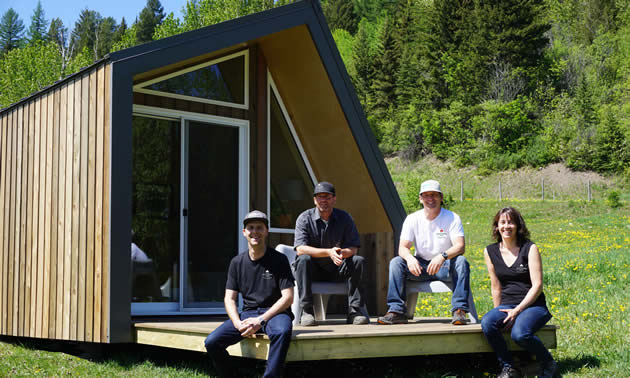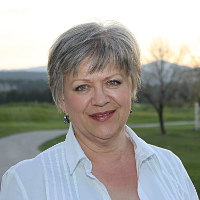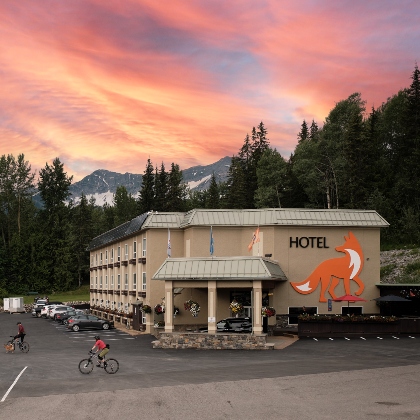Versatile Little Cabins
Little Cabins can be used as extra space for living or for generating income

(L to R) Jude Smith, Ian Larsen, Steve Whelan and Rachel Cline enjoy the sunshine on the deck of a Little Cabin. — Photo courtesy The Little Cabin Company
There are resorts in Canada and the U.S. that charge almost $10,000 per person for an all-inclusive seven-night stay at their “glamping” sites. These sites provide ultra-luxurious features within their roomy guest tents and cabins, along with fine dining, attentive service staff and interesting activities.
If you’d like to venture into the world of glamping, it’s good to know that you don’t have to be stratospherically wealthy to do so. A quick tour of some glamping websites shows many options that are affordable for most of us, especially when you consider the costs of RVing and the absence of comfort that goes along with traditional camping.
Earlier this year, Jude Smith and his wife, Rachel Cline, launched a new, glamping-associated business in the East Kootenay. The couple arrived in Fernie, B.C., from their home in England in 2012 with the idea of establishing their own business.
Observing a rapidly growing market, they decided to focus on the glamping world, and once they aligned themselves with award-winning construction company Larsen & Whelan Enterprises, Smith and Cline saw their business dream materialize. The Little Cabin Company markets small, sturdy, beautifully finished single-room structures that can be used for any purpose you like. And the team at The Little Cabin Company is focusing their efforts on meeting the needs of the glamping industry.
“Our target market is the glamping market,” Smith said. “If you want to offer your guests an opportunity to get into the outdoors and enjoy a connection with nature, without sleeping on the ground, staying in a motel or investing in an RV, then a Little Cabin is a good option. Our cabins offer campgrounds the opportunity to attract a section of the market that they don’t currently have the facilities for.”

This Little Cabin is a secure and cozy home base for your outdoor adventure. — Photo courtesy The Little Cabin Company
Unlike a tiny home, a Little Cabin is not designed for full-time living. Rather, it’s an extra space that can be used as an office, a studio, guest lodging, a retreat or any other function that will fit into the space. The footprint of a Little Cabin is 12 feet by 11 feet, three inches. The construction exceeds current provincial and national Canadian building codes, with a roof that’s guaranteed for 40 years.
“It’s super-insulated for year-round use,” said Smith, “as we want our customers to have the chance to build income in the shoulder season. The interior is finished in cabinet-grade birch panelling, with low-voltage recessed lighting and electric sockets for evening reading or charging portable devices. They’re high quality, locally designed and constructed.”
Across the front of each cabin is a narrow deck sheltered by the roof overhang, and there’s an add-on, hinged deck available that matches the silhouette of the roofline. For security or long-term vacancy, the deck can be raised like a drawbridge to cover the front of the cabin, protecting the windows. The rest of the time, it functions as additional outdoor living space.
The cost of a Little Cabin is $24,995. With no requirement for a building permit or a full foundation, it can be delivered, set down on the levelled site and plugged into a standard power supply, and it’s ready to be used. For off-grid locations, a partnership with Goal Zero provides a solar option.
Smith visualizes his Little Cabins at fly-fishing resorts, equestrian centres, retreat centres and even working farms and ranches—places where you go for an experience. He suggested that Little Cabins would work well for people who have a scenic, undeveloped acreage and might want to get into the glamping business, or would like a comfortable little cabin to stay in when they visit.
Smith said that once they’re properly situated and furnished, Little Cabins could rent out for $100 to $120 per night, providing a rapid return on investment.
“We’ve got a finance package available through the East Kootenay Credit Union so that you can spread payments over five years,” Smith said. “From an investment perspective, you can have a very quick rate of return and establish a healthy business model. These pillars of our offer are intended to make it easy for people to get into business quickly and enjoy access to revenues immediately.”






Comments